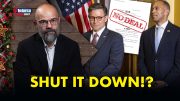
A bill recently introduced in Congress would not end the practice of billionaire owners of professional sports franchises shaking down cities to build them arenas and stadiums, but it would cut out one avenue often used to extract taxpayer dollars through various subsidy schemes.
On June 12, Senator James Lankford (R-Okla.) and Senator Cory Booker (D-N.J.) introduced S.1342, designed to end a provision in the federal tax code that allows professional sports teams to finance new stadiums with municipal bonds that are exempt from federal taxes.
Municipal bonds are often used to give local governments a way to finance projects, such as hospitals, schools, and roads, without having to pay federal taxes on the debt’s interest. According to a statement released by Senator Booker’s office, “Using municipal bonds to finance sports stadiums diverts money away from these critical local infrastructure projects.”
Senator Booker explained the purpose of the Booker-Lankford bill. “Professional sports teams generate billions of dollars in revenue. There’s no reason why we should give these multi-million-dollar businesses a federal tax break to build new stadiums. It’s not fair to finance these expensive projects on the backs of taxpayers, especially when wealthy teams end up reaping most of the benefits.”
“The federal government is responsible for a lot of important functions, but financing sports stadiums for multi-million — sometimes billion — dollar franchises is definitely not one of them,” Senator Lankford added. “Using billions of federal taxpayer dollars for the subsidization of private stadiums when we have real infrastructure needs in our country is not a good way to prioritize a limited amount of funds. I’m pleased to work with Senator Cory Booker to introduce this bill to eliminate the use of federal tax-exempt bonds for sports stadiums. Everyone likes free federal money to build their expensive stadiums, but with $20 trillion in federal debt, this is waste that needs to be eliminated.”
Not surprisingly, powerful corporate interests who have long enjoyed the benefits of government subsidies are not happy with the bill. In Lankford’s home state, the Greater Oklahoma City Chamber of Commerce cited the building of a baseball park in Oklahoma City’s Bricktown and the Chesapeake Energy Arena (where the Oklahoma City Thunder NBA team plays) as examples of sports arenas benefitting the community economically. Kyle Johnston, with the Tulsa Downtown Coordinating Council, praised Tulsa’s BOK Center as bringing a renewed focus on downtown: “Two new hotels have opened up in the last year, and four more are on the horizon for a 2018-19 opening. These are developers catering to the visitors of downtown Tulsa, and their success amounts to success in our local bars, restaurants, shops and art galleries.”
Lankford, however, said that “stadiums have proved to have limited to no impact on local economic development.”
Just since 2000, 36 professional sports stadiums have been constructed or remodeled using financing made possible by federal tax-exempt municipal bonds. It is estimated that this has cost American taxpayers over $3.2 billion. According to Lankford and Booker, 20 years of research has found that “there is no statistically significant correlation between sports facility construction and economic development.”
Unfortunately, even if Lankford and Booker are successful in ending federal subsidies for stadium financing, it would not keep local and state governments from bidding and offering economic incentives to teams. For example, local governments could finance their stadium subsidies with taxes on tickets and in-stadium purchases under the Booker-Lankford legislation.
How did the use of municipal bonds, exempt from federal taxes, ever get started? In the 1986 Tax Reform Act, Senator Patrick Moynihan (D-N.Y.) put into the bill a provision that would help cash-poor cities entice private businesses, such as automobile plants, not to leave town. Moynihan’s bill provided that any time a project was used more than 10 percent of the time by a private entity, and was funded more than 10 percent by a private entity it was a private use, and would thus be ineligible for the tax-free bonds. Despite the law specifically saying that this prohibition applied to sports stadiums, it wound up doing just that.
How? Because cities opted to cover what was needed to keep stadium bonds tax-exempt. According to Neil deMause of Vice Sports, “Moynihan spent the rest of his career trying to close the loophole he’d created, to no avail.”
DeMause wrote, “The tax-exempt bond dodge may be a sizable benefit to team owners, but it’s hardly the most important one.” He then cites the new stadium built by New York City for the Yankees and the Mets in 2009. “According to calculations by the City’s Independent Budget Office, the total bond tax break amounted to $326.5 million for the Yankees and $137.4 million for the Mets.” DeMause noted that this was not the only subsidy enjoyed by the two major-league baseball teams. Other benefits enjoyed by the wealthy owners included $232 million in public funds to move public parks for the Yankee Stadium, and “another $61 million in state funds to build parking garages in the Bronx.”
Especially important was the $768 million in city property tax forgiveness — because the city owns the new stadiums, in name, although they receive no profits from their “ownership.” DeMause estimates that the two teams were given $1.8 billion in “cash, tax breaks, and other subsidies.”
The Brookings Institution reported that 68 percent of the financing for the new Yankee Stadium was through tax-exempt municipal bonds. (In contrast to the original Yankee Stadium, known as “The House that [Babe] Ruth Built,” this stadium was the house that working stiffs in New York City built).
The Yankees and Mets are certainly not alone, of course. In Chester, Pennsylvania, the city provided 97 percent of the money for a new soccer stadium, with a price tag of $117 million. During the 2016 presidential campaign, Republican hopeful Carly Fiorina raised the general issue of “crony capitalism.” According to Fiorina, “What we have now is less and less free market, and more and more crony capitalism.”
While its advocates often tout the visible effects of such spending, such behavior on the part of governments distorts the normal workings of the free market, hurting many other businesses and consumers (who usually do not even know that they are paying higher prices and higher taxes because of it).
The term “crony capitalism” may be relatively new, but the practice of using the power of government to obtain a competitive advantage for politically-connected businesses is not. When President Andrew Jackson vetoed the rechartering bill for the Second Bank of the United States, he wrote in his veto message, “It is to be regretted that the rich and powerful too often bend the acts of government to their selfish purposes.… Every man is equally entitled to protection by law; but when the laws undertake to add to these natural and just advantages artificial distinctions, to grant titles, gratuities, and exclusive privileges, to make the rich richer and the potent more powerful, the humble members of society — the farmers, mechanics, and laborers — who have neither the time nor the means of securing like favors to themselves, have a right to complain of the injustice of their government.”
It is difficult to end the practice of cities paying for new sports venues for wealthy owners. After all, as was the case with the NFL’s Oakland Raiders, if the city refuses to give the billionaire sports owner his subsidy, he can always find a Las Vegas that will. And the officeholder who refused to support subsidizing the sports team billionaire owner will find himself under demagogic attack as “against” the home-town team, and may face defeat in the next election.
Ending the practice of federal tax-exempt bond funds being used on buildings whose primary function is “private business use” is a good start. At least a federal taxpayer in Montana would not have to subsidize the Davis family’s move from Oakland to Las Vegas.
Earlier this month, Al Hruby of Vice Sports offered an even stronger proposal to end the practice, stating, “I have just the idea: a 100 percent federal tax, paid for by the sports teams, on all state and local spending designed to benefit them.”
He conceded that it “sounds excessive,” but he argued it could be necessary to break the power of these crony-capitalist sports owners.
“Like the Wall Street bailouts, stadium subsidies socialize risk and privatize profit,” Hruby wrote. He rightly pointed out that every dollar spent on “refurbishing” some sports arena is a dollar not spent on something else, either in the public or the private sector. The French philosopher Frédéric Bastiat understood this very well in the 1840s, writing in his classic essay, “What is Seen and What is Not Seen,” that everyone sees the visible effects of certain government spending, but do not see that this is money that could have been spent on something else that would have benefitted another person in the society — a person who lacks, as Jackson said, the time or the means of “securing like favors to themselves.”
Photo of Chesapeake Energy Arena in Oklahoma City, by Urbanative, https://commons.wikimedia.org/w/index.php?curid=19005621



